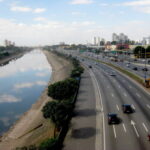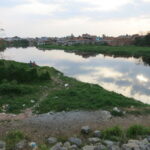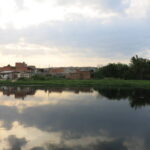Everyday Paths of Water in the City

Over the last fifteen months, it has become increasingly clear that São Paulo, Brazil is in the midst of a profound water crisis. With the primary reservoir system for the city at around 16% of capacity, it is unclear what will happen if rains do not return in the coming months. A product of a complex assemblage of climatic and political factors ranging from the local dynamics of deforestation and inadequate sewage collection to the global dynamics of climate change and real estate speculation, the water crisis continues to mutate and deepen in São Paulo as reservoirs continue to decline. While formal rationing has been avoided, a type of de facto rationing caused by reducing water pressure in the pipes has meant that many urban residents have faced consistent water shortages throughout the past year. Given the broader contours of São Paulo’s deeply unequal landscape, water shortages have primarily affected the urban poor.
São Paulo’s water authorities have proposed a series of infrastructural interventions that are designed to increase the city’s supply of drinkable water by bridging watersheds. Many of these projects are mired in the sorts of delays that typify large-scale hydrological projects, although ongoing efforts on behalf of the state government to bypass environmental regulations may accelerate their progress. While these expensive and environmentally indeterminate projects go forward, critics have called attention to the water losses from leaks in the city’s pipes and a lack of historical preparation for the possibility of a drought. Many have argued that these dynamics are representative of the failures of São Paulo’s partially privatized water management agency to adequately invest in water treatment and sewage infrastructure.
These criticisms make visible the fact that there is in fact considerable water in the city. Indeed, one of the central ironies of the ongoing crisis is the constant visibility of water in São Paulo that is largely inaccessible due to pollution. Water is regularly encountered in the hundreds of streams and creeks that crisscross the city in various stages of channelization, and also in the Billings reservoir, used primarily for the generation of electrical energy. But water can also be more intrusive: its most dramatic appearance is in the form of regularized floods, which have marked the city since its inception and impact the urban periphery most dramatically. The coexistence of flooding with scarcity is one of the central dynamics of São Paulo’s political and ecological landscape.
How do people encounter water every day in São Paulo and how can those encounters lead to solutions? While the water found in São Paulo is often degraded, its presence in the urban fabric suggests that solutions to the ongoing water crisis can be found in smaller-scale investments in sewage collection, reuse, and rainwater collection.
The presence of water in the city can be juxtaposed with the most dramatic example of the city’s ongoing water woes: the Cantareira System, a network of reservoirs that provides around 45% of the city’s water needs. The system was reduced to single digit percentages last year and is currently at 16% capacity. Yet the fact that the system has any water at all at this point is in large part a result of the usage of the so-called “dead volume,” the water that exists below the pumping system and was previously not used. If past metrics were employed to describe the system, the water availability in the Cantareira system would potentially be in the negative.
A corollary to the Cantareira System is the Tietê River, São Paulo’s iconic and long-suffering river. Like the Cantareira System, it is a symbol of an approach to water management that has reached its limit. Encased in concrete, dammed repeatedly, and dangerously polluted, the Tietê embodies São Paulo’s social and environmental woes.
The river, though, is more than just an image of urban degradation. Cutting through much of the city, from the sprawling eastern periferia into the urban core, the river’s path elucidates much of the city’s history and its patterns of inequality and environmental degradation. Already polluted with industrial and agricultural contaminants when it arrives in the city, the river then winds through a series of eastern neighborhoods referred to by some as the várzea.
Here, the river is not yet channelized, and like all rivers it is prone to flooding and its channel is liable to shift across the floodplain. Communities who reside along its edges are regularly forced to confront the deadly dynamics of mismanaged urban rivers in the form of disease and flooding. Due to long-standing patterns of inequality and informality, many low-income communities are located in areas that were kept out of the formal property market, often areas of environmental protection. As such, the margins of rivers and reservoirs have become flashpoints in conflicts between the state and housing movement activists, and projects to clean up the city’s rivers are often seen as efforts to remove low-income communities from the city. Plans to construct a massive park on the banks of the Tietê’s natural course are currently in development, but residents are fighting against the evictions and removals of communities that will accompany the process.
Passing through a dam, the Tietê takes on its more familiar form as a channelized river encased in concrete. Within the landscape of central São Paulo, the river is lost to the highways that ring it, accessible only by car or public transportation. Modified extensively to lower the impacts from yearly flooding, the Tietê is linked into a broader system of hydrological engineering that attempts to funnel stormwater out of the city as fast as possible.
While efforts to clean up the river have been ongoing for nearly three decades, low rates of sewage collection continue to complicate the project. In part this is due to fact that the Tietê is only the last stop in what is a long chain of hydrological processes. Every drop of water that falls in São Paulo and does not evaporate, whether rainwater or untreated sewage, ultimately ends up in the Tietê. As such, efforts to curb pollution in the city require a concerted effort to clean up the countless tributaries that flow through it.
These include streams like the Corrégo Agua Podre. Like the hundreds of other streams [córregos] that run through the city, the Agua Podre bears the scars of inadequate sewage collection, channelization, and neglect. Yet a project is currently underway to build a park on the banks of the stream, which would be a way of providing green space and improving water quality through the use of vegetation. Designed as a corrective to a technical approach to water management, the development of parks on the banks of the city’s rivers suggests new paradigms in water management in São Paulo even as application of these projects remains mixed.
Similarly, groups like Rivers and Roads [Rios e Ruas] are currently involved in projects to call attention to the city’s degraded waterways. Through walking tours that follow the paths of buried rivers, Rios e Ruas call attention to the environmental history of São Paulo and create new relationships between residents and local watersheds.
It has become a bit of a truism within studies of the built environment to assert that infrastructure—the stuff that binds together our cities and our lives—is invisible in spite of its centrality in the experience of contemporary life. It is interesting that the landscapes and technologies that are such essential components of contemporary life—the tubes that carry stormwater and wastewater, the data centers and servers that back up our digital photographs alongside our financial futures, the algorithms that increasingly moderate our lives—are often hidden from view.
For many in São Paulo though, water infrastructure is highly visible, marked by the recurrent problem of flooding that co-exists with scarcity, the stench of polluted waters that permeates both rich and poor neighborhoods, and the efforts by urban residents to gain access to adequate sewage. São Paulo is, in the words of a group of architects at the University of São Paulo, a “fluvial metropolis,” but one where water is often avoided rather than celebrated.
In the midst of a water crisis, the mere presence of water in the city suggests new pathways for managing the crisis and new ways of incorporating water into the ecological and social functions of cities. Bifurcated engagements with water that relegate water to channelized rivers and distant reservoirs are an important component in the managing of urban water supplies, but they threaten to limit and further disconnect cities from the fluvial systems that sustain them. São Paulo’s crisis has made the technical systems of water supply into a subject of everyday conversation, even as it has unevenly distributed water and produced scarcity. It is essential that these conversations are heard and that more attention is paid to the water that is already present in São Paulo.
Featured image: Jardim Romano, São Paulo. The co-existence of flooding and scarcity marks São Paulo’s political and ecological landscape.
Photographs are all the work of Nate Millington. They may be reproduced with permission from the author.
Nate Millington is a PhD Candidate in Geography at the University of Kentucky and a CHE alum. He is interested in the politics of urban environments, public space, and landscape design. He is currently a Fulbright scholar in São Paulo, Brazil. Contact. Twitter.














You must be logged in to post a comment.